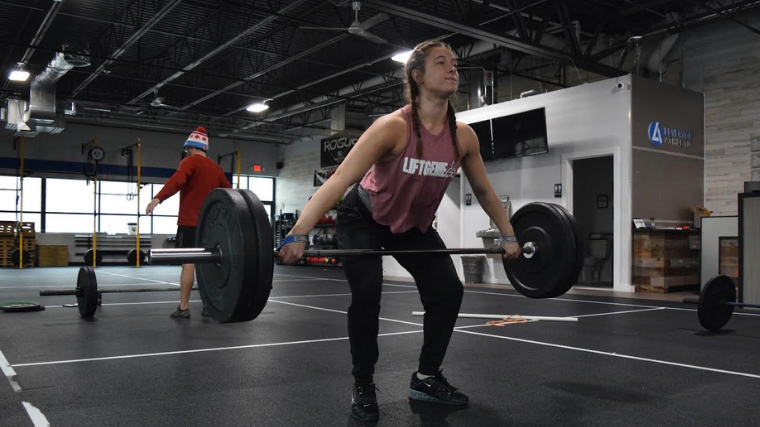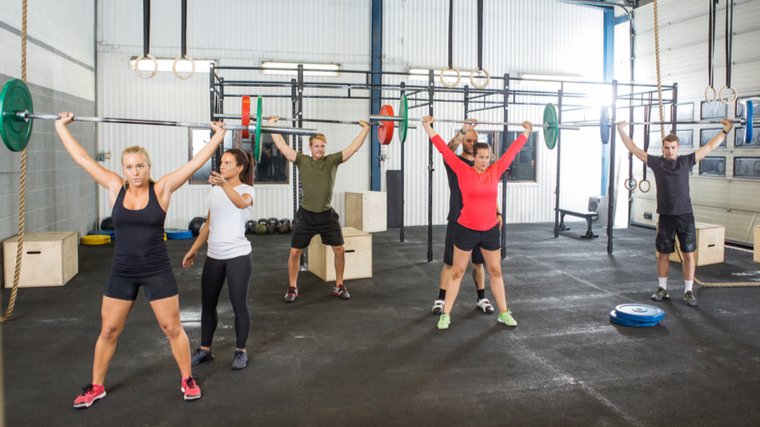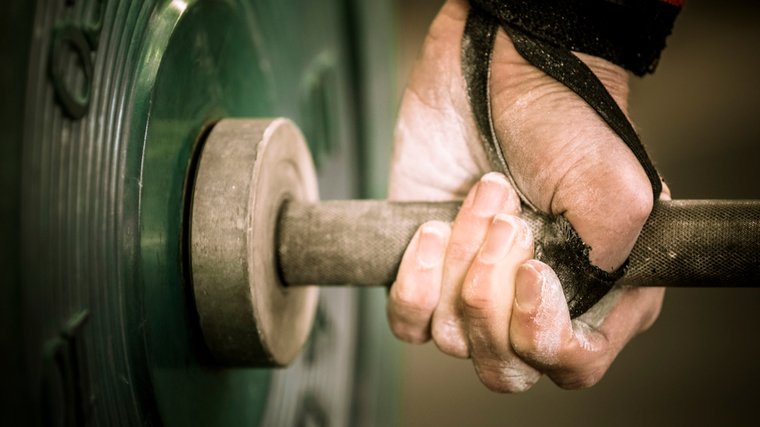How to Properly Warm Up for Weightlifting Workouts
Weightlifting is an intense sport. It’s centered around the snatch and the clean & jerk, but also includes many different other exercises that challenge your body in their own unique ways. No matter what day it is on your program, a thorough warm-up is always step one.
The benefits of warming up for general exercise are well known, but weightlifters in particular rely on their warm-up to perform at their best with a barbell. The warm-up is more than just jogging around the gym a few times — it’s the time to get ready for working at your highest capacity, both mentally and physically.

Depending on your lifting plan, there’s a best way to get ready for action. We’ve got you covered no matter where you are on your Olympic lifting journey.
The Best Warm-Ups for Weightlifting
- The Best Warm-Up for the Snatch
- The Best Warm-Up for the Clean & Jerk
- The Best Warm-Up for Overhead Lifts
- The Best Warm-Up for Strength Work
- The Best Warm-Up for Competition
What’s in a Warm-Up?
A warm-up is a roughly 10-25 minute period of dynamic activity that prepares you for your actual workout. It should start light and gradually build up to mirror your actual exercise intensity.
Warming up for all types of training should start with light cardio such as walking, jogging or biking. The accumulated bodily warmth increases your blood circulation and core temperature. Foam rolling, stretching, and dynamic movement should also be included here if you feel those modalities help you perform better.

A quality warm-up is specific, meaning that no two warm-ups look the same. There are different ways to warm up depending on the type of lifting you’re doing or what your specific limitations may be. These are the best methods of warming up for each day on your plan.
The Best Warm-Up for the Snatch
The snatch is one of the two classic lifts. When snatching, you take the barbell from the ground to overhead — fast. Catching the lift involves overhead squatting, which requires a great extent of mobility in both your upper and lower body.
When it’s time to hit up some snatches, you need to be prepared in terms of explosiveness and mobility alike.
The Warm-Up
Start your snatch day by making sure that both your hips and shoulders are ready for use. You can do this through dynamic stretches, such as resistance banded shoulder openers, and some deep squat practice. Activate your whole body, such as your glutes, quads, and shoulders. You’re then ready to establish your speed.
Advance to a dowel rod or PVC pipe for the snatch and overhead squat. Progress to the empty barbell when it feels right, and make sure to do multiple snatches with the empty bar before adding weight.
- 5-10 minutes of hip & shoulder stretching.
- 5 snatch pulls, 5 power snatches, & 5 overhead squats with a dowel or pipe.
- 1-3 sets of snatches with the rod or pipe.
- 1-3 sets of snatch with the empty barbell.
Following your work with the empty barbell, gradually build to your working sets with 2-5 warm-up sets at lighter weights.
The Best Warm-Up for the Clean & Jerk
The clean & jerk is the other classic lift in weightlifting. In the clean, you catch the barbell at your shoulders in a full squat. Then, in the jerk, you take it all the way overhead to arm’s length. Like in the snatch, your mobility is challenged to its fullest degree, and your speed and power must be ready to go.
Since you work with heavier weights in the clean & jerk, you must also ensure your legs and back are fully primed for big loads.
The Warm-Up
First, prime your body by mobilizing your hips and shoulders. Activate your legs for heavy squat work. Light pressing and squatting movements should make an appearance in your clean & jerk warm-up as well.
The front rack position is of utmost importance here, so your clean catch feels comfortable and confident.
- 5-10 minutes of hip & shoulder stretching.
- Leg activation work such as 3 sets of 5 banded squats.
- 2-3 sets of overhead presses.
- 3 clean pulls, 3 power cleans, and 3 front squats with the empty barbell.
- 5 push presses, 3 split jerks with a pause in the split.*
- 1-3 sets of empty barbell clean & jerk practice.
Then, build to your working set weights with 2-5 warm up sets at lighter weights.
Note: practice the footwork of the jerk without the barbell before this step for best results.
The Best Warm-Up for Overhead Lifts
Many weightlifting movements necessitate that you take the barbell overhead. Pressing, jerking, snatching, you name it, they all require that you go overhead. Not only does this tax your shoulder mobility, but they have to be prepared to hold an incredibly heavy barbell. Solidify this requirement with an upper body warm-up.
The Warm-Up
When you’re going overhead, spend some extra time opening up your shoulders. Support your shoulder stretches with resistance bands or a foam roller where necessary. Do pressing movements and posterior shoulder work with light weights or dumbbells before your lifts. Overall, make sure your shoulders are good to go in all of their ranges.
- 5-10 minutes of shoulder stretches with resistance bands or even a foam roller.
- Dumbbell Overhead Press: 3×10
- Rear Delt Flye: 3×10
- Barbell Strict Press: 3×5
- Empty Bar Practice: 1 to 3 sets of the lift in question.

[Related: Weightlifter Kate Nye Squats All-Time Squat Personal Record of 186KG]
The Best Warm-Up for Strength Work
When you’re deep in a weightlifting program, you’ll likely practice an abundance of strength work, such as squats, pulls, and more. Most strength training for weightlifting involves all of your leg and total body strength, even when doing types of pressing. Complete this warm up so that your full strength is ready to go.
The Warm-Up
First, stretch and activate your hips so you can push through your legs properly. Strength work involves your whole body, so give attention to your shoulders, upper body, and core as well. Next, establish your power through light, speedy repetitions. Gradually apply weight to your movement as you build up to your working sets.
- 5-10 minutes of hip and shoulder stretching/activation.
- Bodyweight Squat: 2×10
- Walking Lunge: 2×10
- Banded Glute Walk: 3×10
- 1 to 3 sets of the movement in question with an empty barbell.
Work up to your heavy lifts with 2-5 warm-up sets.
The Best Warm-Up for Meet Day
Meet day is not just your average day in the gym. A weightlifting competition is where you do your best and heaviest snatches and clean & jerks. It’s why you train in the first place. The right warm-up will make sure that you’re ready. Follow these steps for success on your big day.
The Warm-Up
Your warm-up for the meet should include all the "valuables", such as stretching, foam rolling, muscle activation, etc. Your mobility and power should be set in stone before you pick up the barbell in the back room. Your competition warm-up should be just like any other — start light and easy. Gradually progress toward your first snatches with the empty barbell.
- Stretching and light body movement 30-40 minutes prior to your first attempt.
- Activation work such as a few sets of banded glute bridges or squats.
- PVC pipe drills such as snatch pulls, tall snatches, or overhead squats.
- 2-4 sets of empty barbell snatches 15-20 minutes prior to your first lift.
- 4-6 warm-up sets of snatches, gradually building to your opening weight.*
Note: Typically, lifters work right up to their opening weight in the back room. Take your last warm-up attempt roughly two minutes before you’re called to the stage.
Benefits of Warming Up for Weightlifting
The warm-up is a valuable asset of your workout. It keeps your body healthy and safe, while also increasing the success rate of your movements.

From first-timers to world champions, weightlifters of all backgrounds make their warm-up a priority before they train — and for good reason.
Better Range of Motion
Moving through the snatch, clean, or jerk requires extensive ranges of motion — which you’re not likely to do at your desk job or during yard work. By properly warming up, you’ll be more ready to tackle the deepest ranges of your mobility when you’ve got a barbell in your hands.
Higher Movement Quality
Warming up for your training proper leads to better coordination later on. Even light movements will fire up your central nervous system and help you feel more connected and in-tune with your own movement. You should also notice that your strength "comes online" a bit faster if you’ve practiced your technique in advance.
Pain Management
Weightlifting is an intense sport that demands a lot of your body. Regular heavy lifting causes plenty of muscle tension and soreness, which can lead to injury if you don’t properly care for things. The warm-up period is the best time to address any nagging aches or pains and take the necessary action to modulate or remedy them.
You don’t want to turn a blind eye to a sore hip or crunchy elbow until you’re at your heaviest working set.
Warm-Up Tips and Tricks
Your warm up is most effective when it’s strategically implemented and not just thrown together. Check out these tips on how to get more out of your time.
Start Easy
During exercise, your body works at a higher temperature than at rest. Working muscles require increased blood flow for a better energy supply, which you achieve through accumulating heat in your body. Bring your body up to the right temperature for heavy training by starting with a light cardio warm up.
Be Specific
A warm-up can sometimes pass by quickly, especially if your workout or gym time are limited. Your preparation will result in the most success when your warm-up is functional and relevant to your workout.
Go in with a plan that accounts for the exercises you’re doing and how your body is feeling. If you’ve got heavy squats on the menu, you don’t need to spend 20 minutes warming up for overhead work.
Stay Purposeful
There are plenty of good reasons why you should warm up. Your warm-up is there to support your ability to perform with the bar, get you loosened up, and mentally acclimate you to the demands of lifting heavy. Take advantage of your warm-up period to mentally align yourself with the goals you want to achieve during your workout.
Get Warm
A warm-up is self-explanatory and more literal than you might think. More than anything, your warm-up should accumulate heat in your body so that you’re not stiff or rigid and can move fluidly. To get there, ensure that you elevate your heart rate and turn up your core temperature while you warm up. For best results, you should aim to break a light sweat in your warm-up before you move on.
Warm Up For What?
Weightlifting is fun and exciting, but not every day comes easy. Doing the lifts over and over (and over) puts your body in a high-pressure situation, so you have to make sure that you’re ready for it by warming up the right way.
Practicing weightlifting is most beneficial and rewarding when you start off on the right foot in your warm up. You’ll find that your early sets feel a bit lighter, your last sets are a bit easier to bear, and you’re more likely to leave the gym feeling triumphant instead of deflated.
Featured Image: Riley Stefan
Deja una respuesta

►Te puede interesar...